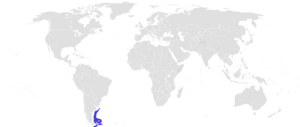Graytail skate facts for kids
Quick facts for kids Graytail skate |
|
|---|---|
| Conservation status | |
| Scientific classification | |
 |
|
| Synonyms | |
|
The graytail skate (Bathyraja griseocauda) is a large type of skate. It lives in the deep waters of the south-western Atlantic Ocean and south-eastern Pacific Ocean. Sadly, it is an endangered species, meaning its numbers are very low. People used to catch them for fishing, and they are still sometimes caught by accident in other fishing nets.
Contents
Where Graytail Skates Live
In the Atlantic Ocean, you can find the graytail skate near the coast of Argentina. They also live in the waters around the Falkland Islands. Their northern limit in the Atlantic is about 37 degrees South.
They can be found a little bit into the Pacific Ocean, off the coast of Chile. However, they don't go further north than 41 degrees South in the Pacific.
Deep-Sea Homes
Graytail skates usually live in deep water. While some have been seen as shallow as 51 meters (about 167 feet), they are most often found deeper than 250 meters (about 820 feet). They are common around the Falkland Islands, especially in the deeper western parts.
Growing Up in Different Depths
Young graytail skates live in different areas than older ones. Baby skates, called juveniles, are often found in "nursery grounds" near the Falkland Islands. These areas are usually 300 to 350 meters (about 984 to 1,148 feet) deep.
As they grow bigger, reaching about 40 to 45 centimeters (about 16 to 18 inches) long, they move. Some go to shallower areas, 200 to 400 meters (about 656 to 1,312 feet) deep. Others move into even deeper water, below 600 meters (about 1,968 feet).
Population Status
We don't know exactly how many graytail skates are left. However, between 1993 and 2001, fewer skates were caught for the same amount of fishing effort. The skates caught were also smaller. These signs showed that their numbers were dropping.
Because of this, some fishing for skates around the Falkland Islands was stopped. But scientists believe that the population might still be declining. This is because skates grow slowly and are often caught by accident in other fishing nets.
Graytail Skate Biology
The graytail skate can grow quite large. Most are about 130 centimeters (about 51 inches) long. The longest one ever recorded was 157 centimeters (about 62 inches) long. Their body, called a disc, can be up to 90 centimeters (about 35 inches) wide.
Appearance
The top side of the graytail skate is dark brown or black. It's covered in tiny bumps called denticles, but it doesn't have any sharp spines on its back. The underside of the skate is yellowish. It has dark spots near its tail. The tail itself has 19 to 27 large spines.
Life Cycle and Growth
Graytail skates grow very slowly, only about 4 to 6 centimeters (about 1.5 to 2.4 inches) each year. This is slower than most other skates in their group. They can live for a long time, up to 28 years!
Female skates become old enough to have babies around 18 years old. Males mature a bit earlier, at about 14 years old. There are slightly more females than males in the population.
Reproduction
Like most skates, the graytail skate lays eggs. They lay their eggs in pairs, and the eggs have horn-like parts. They can lay eggs all year round, but they lay fewer eggs during the winter months.
What They Eat
Younger graytail skates mostly eat small creatures like amphipods and other crustaceans, which are like tiny shrimp or crabs. They also eat polychaete worms.
As they get older, their diet changes. Adult skates eat other types of fish, including ray-finned fish. They also hunt cephalopods, which include creatures like squid and octopus.
Fishing and Conservation
From 1993 to 2001, the graytail skate was the most common type of skate caught around the Falkland Islands. It made up almost a quarter of all skates caught. Other skates caught included the white-dotted skate and the broadnose skate.
Graytail skates are also often caught by accident. This happens in fishing boats that use large nets, called trawlers, to catch other fish. They are also caught by accident on long lines used to catch fish like the Patagonian toothfish. These fishing activities happen near the Falkland Islands, Argentina, and Chile.
Protecting the Skates
The Falkland Islands started a plan in 1994 to manage fishing. This plan divided the fishing areas into two zones. In the northern zone, boats need a special license to fish for skates. In the southern zone, fishing for skates has been completely stopped since 1996.
Unfortunately, as of 2005, Argentina had not yet put a similar plan in place to protect skates and rays.


